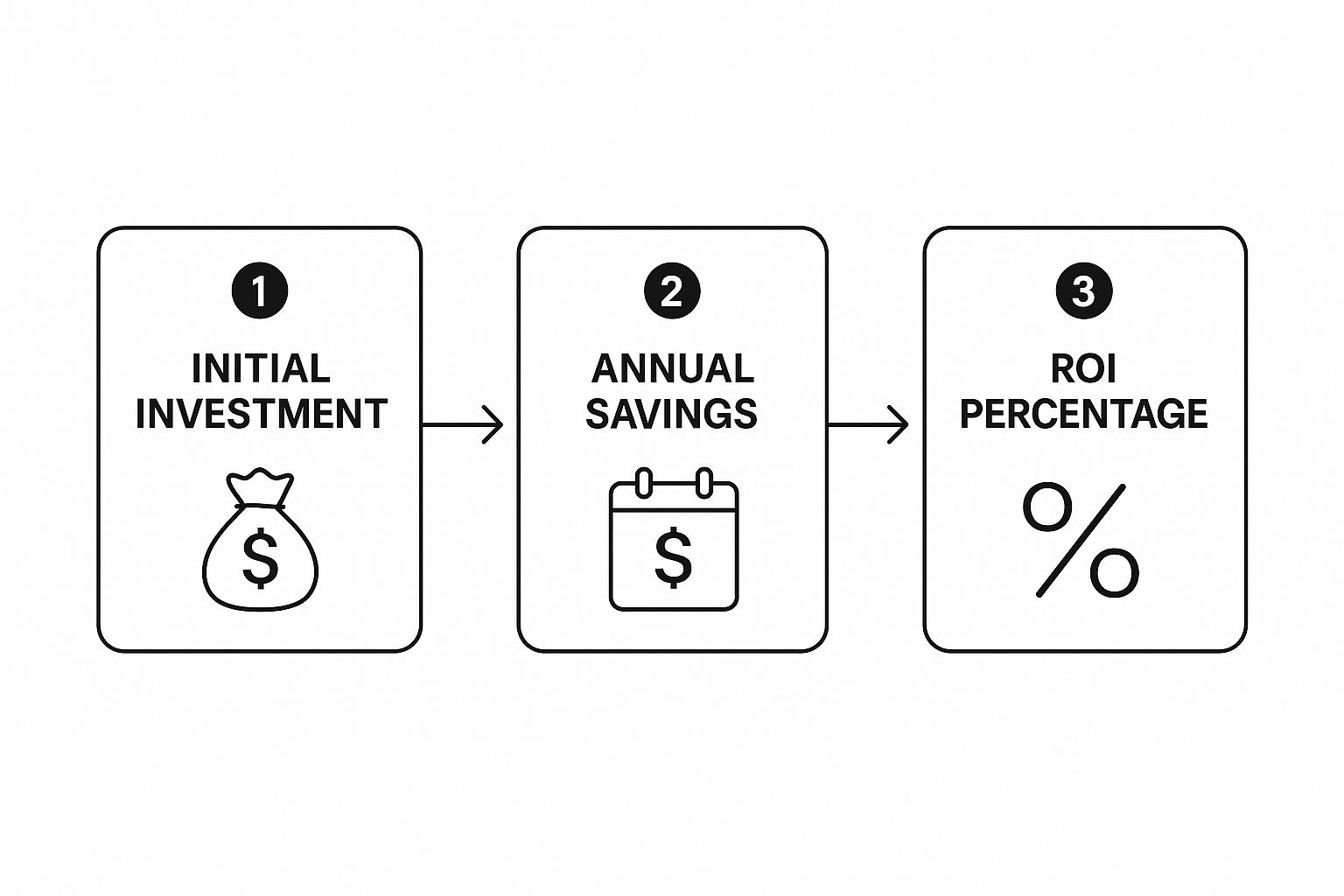Your Guide to Automation ROI Calculation
- Matthew Amann

- Jul 12
- 12 min read
Calculating the return on investment (ROI) for an automation project isn't just a box-ticking exercise. It’s the financial framework you use to measure a project’s real value, comparing what you spend against what you gain. It’s what turns a "gut feeling" about a new technology into a solid, data-backed business case that leadership can get behind.
Why You Can't Afford to Skip an Accurate Automation ROI Calculation
Jumping into an automation project without a clear financial roadmap is one of the most common—and costly—mistakes I see companies make. A solid ROI calculation is your strategic compass. It does more than just justify a purchase; it guides your decision-making and ensures your tech investments are actually helping you hit your most important business goals.
It's How You Get Executive Buy-In
Let's be real: to get any meaningful project funded, you need the green light from the top. A well-researched ROI calculation gives executives the hard numbers they need to confidently sign off.
Instead of a vague pitch like, "this will make us more efficient," you can present a concrete case: "This project has a projected ROI of 75% within 18 months because it will cut down manual data entry by 400 hours every quarter." That’s the kind of language that speaks directly to the company's financial health and strategic growth.
It Helps You Prioritize the Right Projects
Most businesses have a laundry list of processes they could automate, but they only have the budget and people for a few. A formal ROI analysis lets you compare every potential project on an even playing field.
You can objectively see which initiatives promise the biggest bang for your buck. This helps you funnel your limited resources—both money and your team's valuable time—toward the projects that will make the biggest impact. It’s the best way to avoid wasting time on "nice-to-have" automations that don't move the needle.
It Reveals the Full Story of Automation's Value
A thorough ROI calculation forces you to look beyond the obvious cost savings. While cutting labor expenses is often a primary driver, the true, lasting value of automation frequently comes from benefits that are harder to see at first glance.
The most impactful automation projects I've worked on delivered value far beyond the initial cost savings. Things like improved data accuracy, faster customer response times, and a noticeable boost in employee morale are crucial benefits that a good ROI analysis brings to the surface.
This big-picture view helps you tell the complete story. You're not just buying a piece of software; you're investing in tangible business improvements:
Enhanced Capabilities: You gain the power to handle more work without needing to hire more people.
Competitive Advantage: You can get ahead of competitors by delivering services faster and with greater reliability.
Future-Proofing Your Operations: You’re building a more resilient and scalable business that can quickly adapt to whatever the market throws at it.
When you get right down to it, a precise automation ROI calculation elevates your pitch from a simple tech request to a compelling strategic proposal for the entire business.
Before diving into the specific formulas, it's helpful to understand the core pieces you'll be working with. Think of these as the building blocks of your entire analysis.
Core Components of an Automation ROI Analysis
Component Type | Description | Example |
|---|---|---|
Initial Investment | All one-time costs required to get the automation up and running. | Software licenses, implementation fees, hardware, initial training costs. |
Ongoing Costs | Recurring expenses needed to maintain and operate the automation solution over time. | Subscription fees, maintenance contracts, support plans, dedicated staff time. |
Direct Financial Gains | The most straightforward savings, usually related to reducing labor or operational expenses. | Reduced overtime pay, lower spending on temporary staff, material savings. |
Indirect Benefits | Valuable gains that are less direct but have a significant financial impact, often tied to productivity. | Faster process cycle times, increased output, fewer errors needing rework. |
Intangible Benefits | Benefits that are difficult to quantify in dollars but contribute to long-term business health. | Improved employee morale, better customer satisfaction, enhanced brand image. |
Getting a handle on these components is the first step toward building a business case that is both realistic and persuasive. With this foundation, you're ready to start putting the numbers together.
Getting a Real Handle on Your Total Automation Costs

If you want an ROI calculation you can actually trust, you need to be brutally honest about every single cost involved. It’s all too easy to just look at the software license fee and call it a day, but that’s a rookie mistake. Doing so will only lead to skewed numbers and seriously mismatched expectations down the line.
To get a true financial baseline, you have to dig into both the obvious, one-time investments and the sneakier, recurring costs that often get missed.
The initial spend is usually the most straightforward. These are the upfront costs to get the project moving.
Software and Hardware: This could be a one-off license purchase or the cost of new servers or scanners your team needs.
Initial Setup and Configuration: You’ll likely have fees from the vendor or a consulting partner like Flow Genius to get the platform installed and tailored to your specific workflows.
System Integration: This one’s a biggie. Making a new automation tool talk to your existing ERP, CRM, or accounting software almost always requires custom work with its own price tag.
Looking Beyond the Sticker Price
The real challenge—and where most people trip up—is pinning down all the recurring expenses. These ongoing costs are what determine the true total cost of ownership over time. Forgetting them is probably the single biggest error I see people make when calculating automation ROI.
The sticker price is just the beginning. I've seen projects appear profitable on paper, only to become a financial drain because the team didn't account for recurring maintenance, necessary training, and other hidden operational costs. A complete picture is non-negotiable.
Here are the critical ongoing costs you absolutely have to factor in:
Subscription or Maintenance Fees: Most modern platforms are SaaS, meaning you’ll have monthly or annual fees. Even with a one-time license, expect annual maintenance contracts for support and essential updates.
Employee Training: Your team needs to know how to use the new tools. This cost isn't just the training session itself; it's also the time your employees are pulled away from their regular work, plus any resources for creating user guides.
Infrastructure Costs: If your automation is cloud-based, you need to account for monthly data storage and processing fees.
Dedicated Staff Time: Automation isn't "set it and forget it." Someone has to manage, monitor, and troubleshoot the system. You have to allocate a portion of their salary to the project's operational budget.
By meticulously tracking both the initial and ongoing expenses, you build a realistic financial foundation for your analysis. This approach prevents nasty surprises later and turns your ROI calculation into a reliable tool for making smart business decisions.
Uncovering The Full Spectrum Of Automation Benefits

A proper automation ROI calculation goes way beyond just adding up saved labor hours. While slashing direct salary costs is a huge win, it’s often just the tip of the iceberg. The projects with the biggest impact deliver a whole host of benefits, and knowing how to spot and measure them is what separates a decent investment from a truly game-changing one.
To build a business case that gets a green light, you have to tell the whole story. This means thinking about your gains in two different buckets: hard savings and soft benefits. Both are critical for painting an accurate picture of what your automation project will really deliver.
Hard Savings: The Easily Measured Wins
Hard savings are the most straightforward wins. These are the direct, tangible financial gains you can easily see on a spreadsheet. They represent clear cost reductions or expenses you no longer have to pay, making them an easy sell to any finance department.
Think of these as the bedrock of your ROI calculation. Common examples include:
Reduced Labor Costs: This is the big one—fewer hours spent on repetitive manual work, meaning less overtime or a reduced need for temporary staff.
Lower Material Waste: In manufacturing or logistics, automation can dramatically cut down on errors. That means less scrap and fewer wasted resources.
Elimination of Late Fees: Automating your accounts payable process ensures bills get paid on time, helping you dodge those frustrating and costly penalties from suppliers.
These are the most direct benefits to calculate and are absolutely essential for any ROI analysis. Exploring practical business process automation examples can give you a better sense of how these savings play out across different industries.
Soft Benefits: The Powerful Intangibles
Soft benefits are the gains that are harder to pin a precise dollar amount on but are often just as impactful—sometimes even more so. These improvements usually center on things like quality, efficiency, and your team's day-to-day experience. While they might feel less direct, their effect on your bottom line is very real.
You'll find that these benefits create a powerful ripple effect across the entire business.
Don’t underestimate the power of soft benefits. Improved data accuracy prevents costly business mistakes, while higher employee morale reduces turnover and its associated hiring costs. These aren't just feel-good metrics; they have real, long-term financial consequences.
A fantastic real-world example comes from manufacturing, where automated visual inspection systems show a clear return. A $100,000 investment can immediately save $100,000 a year in labor by replacing two manual inspectors. But here's where it gets interesting. That same system might boost Overall Equipment Effectiveness (OEE) by saving 5,000 production minutes annually—adding $25,000 in value—and slash defect costs by another $50,000.
Suddenly, your total annual return isn't just $100,000; it's $175,000, delivering a powerful 75% ROI.
This isn't just a manufacturing story, though. Getting a handle on the full range of benefits is key to any automation project. You can dive deeper into this by reading our guide on the 8 key business process automation benefits for 2025. When you account for both hard savings and soft benefits, you create a holistic and far more accurate ROI calculation.
Applying the Core Automation ROI Formulas
Alright, now for the moment of truth. You’ve painstakingly gathered all your costs and tallied up the potential benefits. It’s time to put those numbers to work and build your business case. This is where we translate all that groundwork into a single, powerful figure that proves your automation project is a smart investment.
The basic automation ROI calculation is surprisingly simple, but don't let that fool you. The strength of your final number is directly tied to the quality and accuracy of the data you've collected.

This flowchart nails the concept: a single, upfront investment can create a ripple effect of savings that continues to pay off long after the initial setup.
The Standard ROI Formula in Action
Let's walk through a real-world example to see how this plays out. Picture an accounts payable department drowning in manual invoice processing. They've identified an automation solution and need to justify the cost.
Here's their breakdown:
Total Annual Benefit: By calculating the time saved on data entry, the elimination of late payment fees, and the reduction in costly errors, they project an annual benefit of $70,000.
Total Investment: The new software subscription, implementation fees, and team training add up to a one-time cost of $40,000.
Now, let's plug these values into the formula:
First, find the net benefit: $70,000 (Annual Benefit) - $40,000 (Investment) = $30,000.
Next, divide that by the initial cost: $30,000 / $40,000 = 0.75.
Finally, turn it into a percentage: 0.75 x 100 = 75%.
The result? A 75% ROI in the first year alone. That’s a number that gets attention in any boardroom.
Pro Tip: Don't just drop the final percentage on the table. When you present your findings, briefly walk your stakeholders through the how. Explaining where your benefit and cost figures came from builds immense credibility and makes your proposal far more convincing.
Adapting the Formula for AI and Dynamic Returns
The standard ROI model works beautifully for straightforward, rules-based automation. But when you introduce AI into the mix, things get more interesting.
Unlike a static process, AI systems are designed to learn and improve. An AI-powered chatbot that correctly handles 70% of customer queries in its first month might be handling 90% a year later—with no additional investment. Its value grows over time.
This means the traditional automation ROI calculation needs a slight adjustment. The core formula, ROI = ((Net Benefit – Total Investment) / Total Investment) × 100, still holds, but the "Net Benefit" figure is no longer a fixed annual number. It becomes a moving target that increases over the project's lifecycle.
To account for this, you should project your benefits over a three-to-five-year period, factoring in an annual increase in returns. This paints a far more realistic picture of the technology’s long-term value. For a closer look at this concept, check out our guide on Automation ROI Your Guide to Maximizing Real Returns.
Calculating ROI for Your Marketing Automation

Marketing is often one of the first, and most impactful, areas where businesses apply automation. To stay competitive, you need a crystal-clear financial picture of what you're getting back from those efforts. It's not enough to just have a marketing automation platform; you have to prove it’s worth the investment. This is where a sharp automation ROI calculation becomes your most valuable tool.
Unlike some operational automation where the gains are purely in time saved, marketing ROI is tied directly to the money-making side of the business—revenue, leads, and customer value. The goal is to draw a straight line from your investment in tools and campaigns to tangible financial results. You're not just saving a few hours; you're building a more profitable growth engine.
To get there, you have to look past the surface-level "vanity metrics" and zero in on what truly affects your bottom line.
Key Metrics for Your Calculation
A solid ROI analysis rests on a handful of crucial performance indicators. Your whole objective is to see how your automation efforts are actually moving the needle on these specific numbers.
Lead Generation Growth: How many more qualified leads are you getting since turning on your automation? For example, did that new email nurture sequence boost your Marketing Qualified Leads (MQLs) by 15%?
Improved Conversion Rates: Look at the percentage of leads that actually become paying customers. Well-timed, personalized follow-ups can give this number a serious lift.
Lower Customer Acquisition Cost (CAC): As automation frees up your team and nurtures leads more effectively, the cost to bring in each new customer should drop. This is a hugely powerful metric to show executives.
Increased Customer Lifetime Value (CLV): Good automation isn't just about getting new customers; it's about keeping the ones you have. By using it for retention and upselling, you increase how much each customer is worth to you over time.
By carefully tracking these numbers before and after you roll out an automation initiative, you can start putting real dollar values on the results.
The real magic of marketing automation ROI is in proving a direct link between a specific workflow—like an abandoned cart email series—and the revenue it brings back. When you can confidently say, "This automation cost us $500 to set up and has already recovered $12,000 in sales," you’ve built an undeniable case for its value.
This kind of focus is non-negotiable today. With 75% of businesses using automation tools and 91% of marketers considering them essential, a solid ROI calculation is simply part of the job. It helps you see which campaigns are giving you the biggest bang for your buck so you can invest your resources wisely.
Once you’ve nailed down the ROI for your current marketing automation, you can explore proven strategies to improve marketing ROI and boost your returns even further. This approach ensures you aren't just measuring success but actively building on it. By connecting every automation effort back to real revenue, you create a powerful, data-driven argument for continued investment in your marketing tech.
Common Questions About Automation ROI
Even with a solid plan, a few questions always seem to pop up when you start digging into an automation ROI calculation. It’s a detailed process, and it's perfectly normal to hit a few snags. Let's walk through some of the most common questions we hear from teams just like yours.
This is about more than just plugging numbers into a formula; it’s about applying that formula with confidence to what’s happening in your business.
How Do I Value Benefits Like Employee Morale?
This is a fantastic question and one that gets to the heart of automation's real impact. While you can't put a dollar sign on "happier employees," you absolutely can measure the financial results of their happiness.
Think about it this way: higher morale almost always leads to lower employee turnover. What does it cost you to recruit, hire, and train a new team member? If your automation project helps reduce annual turnover from 15% to 10%, that 5% drop translates into very real, measurable savings.
What’s a Realistic Timeframe for a Positive ROI?
Honestly, it's all over the map and depends entirely on the project's complexity and upfront cost. A simple Zapier workflow connecting two apps might pay for itself in a few weeks. On the other hand, a massive ERP integration could easily take 18-24 months to break even.
The trick is to set realistic expectations from day one. For most significant projects, a good rule of thumb is to look for a positive ROI within a three-to-five-year window. Many organizations we see hit returns between 150% and 500% in that timeframe, especially when AI is involved.
A huge mistake I see people make is yanking the plug on a project too early. If your initial math pointed to a 24-month payback period, don't get nervous if you're not seeing profits at month six. Trust the data and give the investment time to bear fruit.
For bigger, more complex rollouts, bringing in an expert can make all the difference. Understanding the ins and outs of business process automation consulting that transforms teams can give you a much clearer roadmap and a more reliable timeline.
Should I Use the Same ROI Calculation for Every Project?
Not quite. The core formula—(Gains - Cost) / Cost—is your constant, but the inputs you use will be completely different from one project to the next. Figuring out the ROI for an accounts payable system is a world away from calculating it for a marketing automation platform.
You need to shift your focus depending on what you're trying to achieve.
Operational Automation (like AP): Here, your main wins are time savings, fewer errors, and lower costs per transaction.
Marketing Automation: The conversation switches to revenue. You're tracking lead conversion rates, customer acquisition cost (CAC), and customer lifetime value (CLV).
Test Automation: For this, the benefits are all about speed and quality—getting to market faster, improving accuracy, and expanding test coverage.
The fundamental logic stays the same, but a truly useful ROI calculation means tailoring your analysis to the specific business function you're improving. That’s how you make sure you’re measuring what actually matters.
Ready to stop wasting time on manual tasks and start seeing real returns? The experts at Flow Genius design and implement custom automation solutions that eliminate operational bottlenecks and drive measurable growth. Book a discovery call today and find out how much time and money you could be saving.

Comments